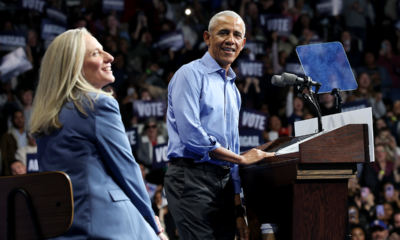INTERNACIONAL
LISTEN: Unhinged voicemail exposes left-wing candidate’s death threats against GOP senator

NEWYou can now listen to Fox News articles!
Freshman Sen. Tim Sheehy, R-Mont., was targeted with death threats and other extreme insults by a left-wing city commissioner candidate from Montana’s capital city of Helena, who called his office several weeks ago to leave her thoughts about the Republican senator over a voicemail.
The voicemail came in July, shortly after Sheehy voted with his Republican colleagues to pass the One Big Beautiful Bill Act, a sweeping tax and spending package from Republicans that angered many Democrats, including Helena city commissioner candidate Haley McKnight, following its passage.
«Hi, this is Haley McKnight. I’m a constituent in Helena, Montana,» McKnight started off in her voicemail, a recording of which was obtained and verified by Fox News Digital. «I just wanted to let you know that you are the most insufferable kind of coward and thief. You just stripped away healthcare for 17 million Americans, and I hope you’re really proud of that. I hope that one day you get pancreatic cancer, and it spreads throughout your body so fast that they can’t even treat you for it.»
But the anger didn’t stop there. During the roughly minute-long voicemail that phone logs reportedly show came in on the afternoon of July 1, McKnight launches into insults about Sheehy’s fertility and his children, before warning the senator not to «meet me on the streets.»
LAWMAKER TARGETED WITH DEATH THREAT AFTER CONDEMNING RACIST SIGN AIMED AT WINSOME SEARS
U.S. Sen. Tim Sheehy, R-Mont., (left) and Helena City Commissioner candidate Haley McKnight (right). (Photos from Haley for Helena and Andrew Harnik via Getty Images)
«I hope you die in the street like a dog,» McKnight continued. «One day, you’re going to live to regret this. I hope that your children never forgive you. I hope that you are infertile. I hope that you manage to never get a boner ever again. You are the worst piece of sh– I have ever, ever, ever had the misfortune of looking at … God forbid that you ever meet me on the streets because I will make you regret it. F— you. I hope you die.»
McKnight added that Sheehy doesn’t «serve Montanans,» but rather just his «own private interests.»
«All that you have done since you have gotten into power is do sh– for yourself.»
SENATORS MAKE BIPARTISAN CALL TO ‘TURN DOWN THE HEAT’ ON POLITICAL VIOLENCE, RHETORIC
McKnight, originally from North Carolina but now living and working in Montana, owns a small business called Sage & Oats Trading Post, which McKnight describes as «a successful Native American-owned gift store» on her campaign website. She also runs a consulting and design business called Morningstar Design Ltd Co, and is the president and a board member of the Helena Young Professionals group. She touts being the recipient of the Helena Chamber’s 20 under 40 award.
«I am always ready to stand up for what I believe and challenge the status quo,» McKnight’s «About» web page on her campaign website reads, which lists priorities like housing for all, better governmental transparency, increased funding for public art and music, and more accessible streets and downtown living.

Montana State Capitol building, located in Helena, Montana. (Photo by: Education Images/Universal Images Group via Getty Images)
In an interview with a local news outlet, McKnight touts her past volunteer work for the Obama campaign and more recently working on Democrat candidate Steve Held’s campaign for Congress. Held did not make it out of the primary.
Meanwhile, public campaign donation records reportedly show McKnight has donated to multiple Democratic candidates, according to records reviewed by Fox News Digital.
The Helena city commissioner race, which is traditionally nonpartisan, is her first time running for any sort of political office. McKnight was originally one of five declared nonpartisan candidates before she advanced to the November general election after finishing third in a nonpartisan primary in September.
«I’m a constituent, and I was responding to some horrible policy with some justified rage,» McKnight told Fox News Digital about the voicemail when reached for comment. «I would hope that if Sheehy was so rattled by my voicemail, he would have contacted me instead of leaking my information to conservative news media the night before an election. It feels like a cheap shot. I’m one of his constituents, and you know, this message is nothing that I’d say to my grandmother or in front of any children, it was meant for Senator Sheehy alone.»
McKnight said it was «laughable» that this is how Sheehy responds to constituent voicemails.
ANTISEMITISM WATCHDOG ISSUES SCATHING ‘ALARM BELL’ REPORT ON MAMDANI AS NYC ELECTION NEARS
«I also would have thought that somebody from the armed forces could have handled some tough language,» McKnight added. Sheehy is a former Navy SEAL who was shot while deployed in Afghanistan.

Tim Sheehy, founder of Bridger Aerospace, seen in the Bridger hangar in Bozeman, Montana, US, on Thursday, Jan. 18, 2024. Sheehy is a former Navy SEAL. (Photographer: Louise Johns/Bloomberg via Getty Images )
Meanwhile, McKnight went on to say she was simply trying to «convey the gravity of the situation» with her voicemail. She added that she was not intending to threaten Sheehy with her voicemail. McKnight also reportedly told the National Review she «obviously» had no intent of hurting Sheehy, reportedly telling the outlet: «I couldn’t, I’m a woman.»
«I wanted to drive home the struggles that people that I know are going through because of his policies. I think people were kind of shocked at my specificity, but these are things that are affecting people in my community,» McKnight told Fox News Digital, adding that Sheehy was spending too much time blocking the release of «the Epstein files» as opposed to understanding the struggles Montanans are going through.
But, when pressed on whether McKnight stood by her rhetoric from the voicemail, particularly after public officials from both sides of the aisle have called for folks to turn down the heat in light of the spate of political violence that the United States has faced recently, she simply responded: «No comment on that.»
«I have received numerous death and rape threats since this story has been published,» McKnight said when pressed even further. «My business is being threatened at the moment because of the actions of the senator,» she added, in reference to Sheehy publicly sharing her voicemail with the media.
ACQUITTAL OF MAN WHO URGED VIOLENCE AGAINST TRUMP PUTS FIRST AMENDMENT IN SPOTLIGHT
«It’s completely politically motivated,» McKnight concluded. «It’s a cheap shot the night before an election … the only thing left I have to say is release the Epstein files.»
Montana has no major statewide elections this year.

Tim Sheehy prepares to debate U.S. Sen. Jon Tester on campus at the University of Montana in Missoula, Mont. Sheehy eventually beat Tester in the subsequent election to take over his Montana Senate seat. (The Missoulian via AP)
In comments to the National Review, McKnight added that, «to see [Sheehy] throw away what Montanans need and want for his own betterment is enough to make me, yeah, want to fight him on site.»
«I’ll gladly say that, because I think in the time of rising fascism, we shouldn’t be afraid to say these things,» she added.
Meanwhile, when pressed by the outlet over whether she thought her voicemail went too far, McKnight reportedly said she didn’t think so, adding that she has had friends die of pancreatic cancer because of an inability to access care they required. «This is a man who’s so rich that he’s never, ever going to have to deal with that problem,» McKnight reportedly said.
In her comments to Fox News Digital, McKnight also recalled having a friend die from pancreatic cancer «because he couldn’t afford to treat it.»
CLICK HERE TO GET THE FOX NEWS APP

Montana Republican U.S. Senate candidate Tim Sheehy speaks during a rally for Donald Trump when he was running for president, at the Brick Breeden Fieldhouse at Montana State University on August 9, 2024 in Bozeman, Montana. (Michael Ciaglo/Getty Images)
McKnight, much like Democrat Attorney General candidate in Virginia, Jay Jones, who has been in hot water for comments about wanting to murder his political rival and his family, is an example of heightened political rhetoric that members of Congress and other public officials have expressed concern over.
«It doesn’t matter if it’s coming from one side or the other, directed at one party or another, or one person or another. It is all wrong – and it makes us all less safe,» Pennsylvania Gov. Josh Shapiro, a Democrat, said of political violence in September following the assassination of Charlie Kirk. Shapiro has been joined by members from both parties calling on others to turn down the heat amid a spate of political violence the country has seen.
When reached for comment about the voicemail, Sheehy spokesman Tate Mitchell said, «We hope Ms. McKnight gets the help she clearly needs and wish her well.»
montana,controversies state and local,state and local,senate,assassinations murders
INTERNACIONAL
La “teoría del pájaro”: la prueba viral que pone a prueba la conexión de una pareja

Layne Berthoud, terapeuta ocupacional que vive en Los Ángeles, no esperaba que su reciente publicación en TikTok acumulara casi 5 millones de visitas en cinco días.
“Hoy vi un pájaro”, expresa Berthoud, de 30 años, a su marido, Alexandre Berthoud, en el video. Él hace una pausa, brevemente desconcertado por la noticia.
“¿Ah, sí?”, pregunta.
En ese momento, Alexandre Berthoud, también de 30 años, superó sin saberlo la más reciente prueba viral de las redes sociales para una relación: la teoría del pájaro o teoría del pajarito.
Leé también: La IA entra en la intimidad: el 30% de las parejas ya usa ChatGPT para resolver conflictos
Los pasos iniciales son sencillos. Uno de los integrantes de la pareja le señala un pájaro al otro, o, en una variante habitual, menciona un falso encuentro con un pájaro ocurrido anteriormente, y espera una respuesta. Quien responde con curiosidad supera la prueba. El que no, falla. Según expertos, publicar un fracaso en la prueba del pájaro puede a su vez crear una especie de camaradería. (Foto: Freepik)
La prueba pretende medir la disposición de la pareja para responder lo que los terapeutas llaman “peticiones u ofrecimientos de conexión“, un concepto popularizado por el investigador matrimonial John Gottman.
Gottman, que trabaja con su esposa, Julie, sostiene desde hace tiempo que las parejas más felices reconocen con facilidad y regularidad, o “se acercan a”, los cientos de peticiones que cada persona presenta a la otra a lo largo del día. Un estudio clásico suyo llegó a la conclusión de que las parejas que permanecen casadas se acercan a las propuestas del otro alrededor del 86 por ciento de las veces; las que se separan lo hacen solo el 33 por ciento de las veces. Pero, ¿es realmente la teoría del pájaro una medida significativa de la conexión en una pareja?
“Tengo sentimientos encontrados al respecto”, explicó Carrie Cole, quien, como directora de investigación del Instituto Gottman, sin duda lo sabría. “Queremos que las parejas se acerquen el uno hacia el otro, y una forma de hacerlo es haciendo estas pequeñas peticiones que en realidad no tratan sobre nada: ‘¡Qué pájaro tan genial!’, ‘¡Mirá ese barco!’, ‘¡Que auto tan lindo!’”.
Leé también: De los príncipes azules al “Shrekking”: cómo cambian las reglas de las citas en 2025
Lo que le preocupa a Cole es la idea de poner a prueba a la pareja con un escenario artificioso y luego darle demasiada importancia a los resultados.
“¿Y si la pareja falla?”, preguntó. “Porque no son todos perfectos. Las parejas felizmente casadas no son perfectas. ¿Y entonces qué?”.
¿Estamos bien?
El test del pájaro es la vara que mide a las relaciones en las redes sociales, pero no es la única que se popularizó.
En un ejemplo reciente, muchos usuarios de TikTok, en mayoría mujeres, acudieron masivamente a la «teoría de la cáscara de naranja“. (Se debe pedirle a la pareja que haga algo que uno pueda resolver fácilmente, como pelar una naranja. Si la pareja lo logra, ¡bandera verde! Si no, ¡bandera roja!) Varios meses después, se inició el debate sobre el «trato de princesa“. Los expertos precisaron que este tipo de viralizaciones indican una “mirada colectiva a lo que se debe soportar”. (Foto: Freepik)
Alexandra Solomon, psicóloga clínica y presentadora del pódcast Reimagining Love (Reimaginando el amor), sostuvo que ese tipo de pruebas o conversaciones en las redes sociales le recordaban los cuestionarios sobre relaciones que solían aparecer en las revistas para adolescentes y mujeres. (En los videos sobre la teoría del pájaro predominan las mujeres que ponen a prueba a sus parejas masculinas).
Una de las preguntas que suelen darse en las relaciones íntimas y a lo largo de ellas es: “¿Estamos bien? ¿Cómo estamos?”, manifestó, y añadió que siente “mucha compasión” por el auge de este tipo de exámenes.
El gran número de videos recientes sobre la teoría del pájaro, y los millones de visitas que obtienen, dice algo sobre la sed colectiva de saber por qué las relaciones íntimas fracasen o prosperen, sostuvo Solomon. Y estas pruebas pueden ofrecer una sensación de validación.
Leé también: Del enojo al reencuentro: estrategias para superar las peleas en una relación de pareja
“Hay un poco de alarde si la pareja supera una prueba”, expresó Solomon. Publicar un fracaso en la prueba del pájaro puede a su vez crear una especie de camaradería, aseveró, al corresponder con el tópico del “hombre desventurado” tan popular en la actualidad.
Los videos indican una “mirada colectiva a lo que se debe soportar”, señaló Solomon.
‘Una oportunidad para una conversación más profunda’
A pesar de la popularidad de los tests de TikTok, los expertos en relaciones explicaron que esos exámenes o pruebas no suelen ofrecer mucha información significativa sobre la salud de una relación y que obviamente pueden ser contraproducentes.
“Si no superan la prueba, espero que la gente no se lo tome como una señal de que la relación está condenada a fracasar“, formuló Cole. “Espero que lo vean como una oportunidad para una conversación más profunda sobre cómo satisfacer sus necesidades”.
Layne Berthoud está felizmente casada, así que tenía la corazonada de que su marido pasaría la prueba, aunque la mayoría de las parejas de tiktokers “fallaron”, al actuar con desdén u ofreciendo una respuesta tibia. La prueba pretende medir la disposición de la pareja para responder lo que los terapeutas llaman «peticiones u ofrecimientos de conexión“. (Foto: Adobe Stock)
Alexander Berthoud no tiene TikTok y ni siquiera conocía el video hasta que su mujer lo llamó para decirle que estaba empezando a hacerse viral. Dijo que le hizo gracia los comentarios, la mayoría positivos.
“La gente que debate sobre la vida de otras personas en un video de 30 segundos, y todas las suposiciones que hace, es algo divertido”, manifestó. “Es como un estudio total de la humanidad”.
Pero la pareja sostiene que nunca se pone a prueba de ninguna manera significativa, y que se esfuerzan por estar presentes en su relación todos los días: lavan los platos cuando no les parece, se compran regalos considerados y, sí, aceptan las pequeñas insinuaciones de conexión de cada cual.
Leé también: La “generación sin sexo”: por qué los jóvenes de todo el mundo se relacionan cada vez menos
“Si realmente tuviera dudas profundas sobre mi relación, probablemente no lo grabaría”, precisó Layne Berthoud, “y definitivamente no lo publicaría”.
*Catherine Pearson es reportera de la sección Well del Times. Escribe sobre temas de familia y relaciones.
The New York Times, Parejas, amo, Vínculos
INTERNACIONAL
Zelenskyy: Ukraine ‘confidently moving toward’ EU membership after European Commission progress report

NEWYou can now listen to Fox News articles!
Ukrainian President Volodymyr Zelenskyy said his country is making key progress toward becoming a member state of the European Union (EU).
«The European Commission’s Enlargement Package Report confirms: Ukraine is confidently moving toward EU membership and ready to open Clusters 1, 2, and 6,» Zelenskyy wrote Tuesday on X.
«This is the best assessment to date—proof that even as we defend against Russia’s full-scale aggression, Ukraine continues to reform and transform according to European standards.»
Ukraine has been an EU candidate country since it applied for membership in February 2022, days after Russia’s invasion began.
Ukraine’s President Volodymyr Zelenskyy speaks during a press conference at an EU Summit in Brussels, Belgium, on Thursday, Oct. 23, 2025. (Geert Vanden Wijngaert/AP)
EUROPEAN LEADERS WILL JOIN TRUMP-ZELENSKYY MEETING, SIGNALING SOLIDARITY WITH UKRAINE
The European Commission released its 2025 Enlargement Package Report Tuesday, providing a status update on the progress of Montenegro, Albania, Ukraine, the Republic of Moldova, Serbia, North Macedonia, Bosnia and Herzegovina, Kosovo, Turkey and Georgia in meeting the conditions for EU membership.
The commission praised Ukraine for showing «remarkable resilience» in the face of Russia’s invasion and a «strong commitment» to its EU accession path, but noted concerns about the country «ensuring a robust and independent anti-corruption framework.»
Zelenskyy signed a controversial bill into law in late July that critics said would undermine the independence of Ukraine’s key anti-corruption agencies, the National Anti-Corruption Bureau (NABU) and the Specialized Anti-Corruption Prosecutor’s Office. Following public protests across Ukraine and international pressure, he signed a new law on July 31 reversing the changes.
The commission called on Ukraine in its report to preserve the independence of anti-corruption institutions and to expand the jurisdiction of NABU.

Ukrainian MPs vote for a bill stripping anti-corruption institutions of their independence on July 22, 2025, in Kyiv, Ukraine. Parliament moved to curtail the autonomy of the National Anti-Corruption Bureau and the Specialized Anti-Corruption Prosecutor’s Office. (Andrii Nesterenko/Global Images Ukraine via Getty Images)
«Ukraine has adopted roadmaps on the rule of law, public administration, and the functioning of democratic institutions, as well as an action plan on national minorities, which the Commission assessed positively. Ukraine has met the conditions required to open clusters: one (fundamentals), six (external relations), and two (internal market),» read a press release from the European Commission.
«The Commission expects Ukraine to meet the conditions to open the remaining three clusters and works to ensure that the Council is in a position to take forward the opening of all clusters before the end of the year.»
ZELENSKYY ARRIVES IN WASHINGTON, DC FOR TRUMP MEETING, URGES LASTING PEACE WITH RUSSIA
It added that the Ukrainian government has signaled its objective to provisionally close accession negotiations by the end of 2028.
«The Commission is committed to support this ambitious objective but considers that, to meet it an acceleration of the pace of reforms is required, notably with regards to the fundamentals, in particular rule of law,» the press release continued.
Yulia Svyrydenko, Ukraine’s prime minister, wrote on X that the report showed the country’s best result in three years.
«The course toward EU membership remains among the top priorities of our President, Parliament, and Government,» she said.
CLICK HERE TO DOWNLOAD THE FOX NEWS APP
Hungarian Prime Minister Viktor Orbán, who has blocked Ukraine’s EU accession progress, told reporters in October that he’s proposed a «strategical agreement» with Kyiv instead of advancing talks toward full EU membership.
«Membership is too much,» Orbán explained. «We need [a] strategic agreement only.»
ukraine,volodymyr zelenskyy,world,the european union,europe
INTERNACIONAL
Por qué los cerebros de mamíferos y aves son más grandes, según un estudio

El enigma de por qué algunos vertebrados, como mamíferos y aves, desarrollaron cerebros proporcionalmente grandes, mientras que otros, como peces y anfibios, presentan cerebros mucho más pequeños, intrigó a la biología evolutiva durante décadas.
Un estudio internacional liderado por el Max Planck Institute of Animal Behavior y publicado en Proceedings of the National Academy of Sciences (PNAS) aporta una explicación integral: la capacidad de mantener una temperatura corporal elevada y la producción de crías grandes son los factores clave que permitieron la encefalización en ciertos linajes de vertebrados.
La variabilidad en el tamaño cerebral entre vertebrados es notable. Según la Max Planck Society, incluso entre especies de tamaño corporal similar, el tamaño del cerebro puede variar hasta cien veces. Mamíferos y aves encabezan la lista con los cerebros más grandes en relación con su cuerpo, seguidos por tiburones y reptiles, mientras que anfibios y la mayoría de los peces óseos se sitúan en el extremo opuesto, con los cerebros más pequeños.
Esta disparidad no se explica únicamente por diferencias en la complejidad social o ecológica, ya que, como señala el estudio, incluso aves y mamíferos con dietas y estructuras sociales simples superan ampliamente en tamaño cerebral a peces con sistemas sociales complejos.

La llamada hipótesis del cerebro costoso fue central para entender estas diferencias. De acuerdo las investigaciones, el cerebro es un órgano que demanda energía de forma constante, sin posibilidad de reducir su consumo durante el sueño o el ayuno.
Por tanto, el crecimiento cerebral solo es viable si el organismo puede generar la energía adicional necesaria o si el aumento de capacidad cognitiva compensa con creces el coste energético, permitiendo sobrevivir y reproducirse aunque sea a un ritmo más lento. Esta hipótesis se confirmó en varios grupos: por ejemplo, los primates que no enfrentan periodos de escasez alimentaria tienden a tener cerebros más grandes, y las aves sedentarias superan en tamaño cerebral a las migratorias.
El estudio evaluó dos predicciones principales de la hipótesis del cerebro costoso en una muestra de 2.600 especies de vertebrados. En primer lugar, analizó el papel de la inversión parental, especialmente la producción de crías grandes y el cuidado antes y después del nacimiento.
Los resultados muestran que la protección y provisión parental, tanto en la fase de huevo como en la de embrión, se asocian con la evolución de crías de mayor tamaño, lo que a su vez permite el desarrollo de cerebros más grandes en la adultez. Este patrón se observa de forma clara en mamíferos, aves y peces cartilaginosos (como los tiburones), pero no en reptiles, anfibios ni la mayoría de los peces óseos.

En segundo lugar, el estudio examinó la influencia de la temperatura corporal. Según la Max Planck Society, las especies capaces de mantener una temperatura corporal elevada y estable pueden permitirse cerebros más grandes, ya que el rendimiento cerebral mejora en ambientes cálidos.
Esta relación positiva entre temperatura corporal y tamaño cerebral se confirmó en todos los grupos analizados, aunque solo alcanzó significación estadística en los linajes más encefalizados: mamíferos, aves y peces cartilaginosos. Además, el análisis conjunto reveló un efecto sinérgico: la combinación de crías grandes y temperatura corporal alta potencia el desarrollo de cerebros grandes.
La endotermia, es decir, la capacidad de generar y mantener el calor corporal independientemente del ambiente, emerge así como un factor decisivo. Mamíferos y aves, ambos endotermos, presentan cerebros aproximadamente diez veces más grandes que los de los ectotermos (animales cuya temperatura depende del entorno) de tamaño similar.
Sin embargo, la endotermia por sí sola no basta para explicar todas las diferencias: la inversión parental es igualmente crucial. Por ejemplo, los tiburones, aunque son ectotermos, pueden mantener temperaturas corporales elevadas gracias a adaptaciones fisiológicas y comportamentales, y además producen crías grandes, lo que explica su tamaño cerebral comparable al de aves y mamíferos.

El caso de los tiburones ilustra cómo ciertas excepciones confirman la regla general. Según la Max Planck Society, muchos tiburones viven en aguas cálidas y presentan crías grandes, lo que les permite desarrollar cerebros de tamaño similar a los de los vertebrados endotermos.
En estos peces cartilaginosos, la temperatura corporal puede superar en hasta 20 ℃ (68 ℉) la del agua circundante, gracias a mecanismos como la producción muscular de calor y la circulación sanguínea contracorriente.
Por el contrario, reptiles y peces óseos, aunque en algunos casos pueden elevar su temperatura corporal mediante el comportamiento (como el asoleo en reptiles), suelen estar limitados por la variabilidad ambiental y la falta de cuidado parental intensivo, lo que restringe su encefalización.
La evolución de la endotermia probablemente no se debió originalmente a la necesidad de cerebros grandes, sino a otras ventajas adaptativas, como la actividad nocturna en mamíferos o el vuelo sostenido en aves.

Solo posteriormente estas innovaciones fisiológicas abrieron la puerta al crecimiento cerebral. Además, la investigación destaca que la evolución de crías grandes está facilitada por la fertilización interna, una condición presente en los linajes más encefalizados.
El profesor Carel von Schaik, del Max Planck Institute of Animal Behavior, resume la importancia de estos hallazgos: “Los humanos tuvimos la suerte de ser de sangre caliente. Además, nuestros bebés son grandes y reciben alimento durante años. Esto permitió la evolución de uno de los cerebros más grandes de todos los vertebrados en relación con el peso”.
A pesar de la solidez de los resultados, los autores reconocen ciertas limitaciones, como la escasez de datos sobre el cuidado postnatal en ectotermos y sobre las temperaturas corporales en algunos grupos. Sin embargo, tanto Max Planck Society, en el estudio publicado en PNAS, afirma que la combinación de inversión parental y temperatura corporal elevada explica de forma coherente la distribución del tamaño cerebral en los vertebrados.
En última instancia, la investigación publicada en PNAS concluye que la encefalización solo pudo prosperar cuando los padres lograron invertir más en cada cría y mantener temperaturas corporales elevadas. Estas innovaciones independientes permitieron a los organismos aprovechar los beneficios cognitivos y sensoriomotores de cerebros más grandes, desencadenando procesos coevolutivos que hicieron posible la aparición de linajes con cerebros excepcionalmente desarrollados, como el humano.

 CHIMENTOS2 días ago
CHIMENTOS2 días agoPaula Robles rompió el silencio tras las amenazas de muerte a Juanita Tinelli, su hija: “Hay otro mundo en el que sí tenemos posibilidades”

 CHIMENTOS2 días ago
CHIMENTOS2 días agoLamine Yamal contó toda la verdad sobre las infidelidades a Nicki Nicole y fue tajante: “Todo lo que está saliendo no tiene nada que ver”

 POLITICA3 días ago
POLITICA3 días agoTras los cambios de Gabinete, Milei viaja a Miami para participar de una cumbre global junto a Trump

























